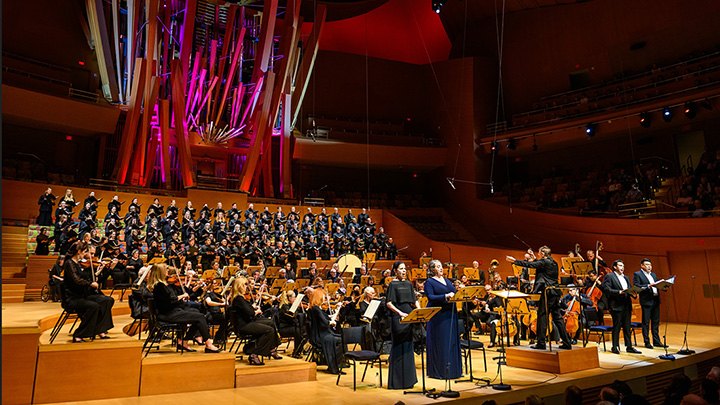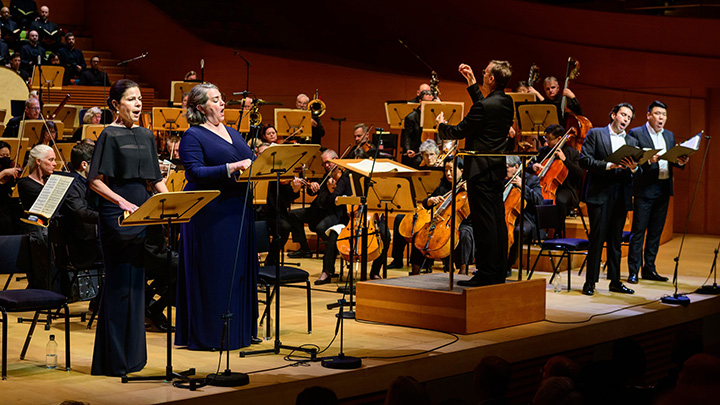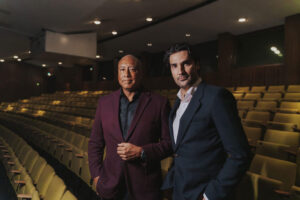Teeny made two commercial recordings (the first in 1961 under Fritz Reiner finds her far fresher than 1977 in Chicago with Solti), but still, I love them both. The discovery of the film she made under von Karajan at La Scala, with Cossotto, Pavarotti (before he could shave) and Ghiaurov, in 1967 when it was released on Laserdisc almost sent me into spasms of apoplexy. There she was. Simple black dress discreetly decorated with bugle beads, hair in an up-do, and two simple strands of opera length pearls singing just for me. It was like a miracle. The rest of the cast was pretty good as well.
My first experience with the Requiem live was when I sang in the tenor section of the Baltimore Symphony Chorus in 1993 under David Zinman. For this event we were joined by the Chorus of the University of Maryland, making us nearly two hundred strong. They had to erect a special wooden bleacher in Meyerhoff Hall to accommodate all of us. Our soloists were Camellia Johnson (in a zebra-print caftan with monkey-fur trim), Florence Quivar, Ben Heppner (who had only won the Met Auditions in ‘88) and Gary Relyea (father of John). It was a pretty spectacular event, even though none of the reviews mentioned my participation.
When Dudamel led the LA Philharmonic and the Master Chorale at the Hollywood Bowl in 2013, I made certain to be there and reviewed the eventual release for home video on these pages. It’s been quite a while since then so I was thrilled when the LA Master Chorale announced their own performance for this year with a cast of singers I was very excited to hear in the spectacular acoustics of Walt Disney Concert Hall.
Alessandro Manzoni was an Italian author, philosopher, and patriot whom Verdi admired tremendously throughout his own life They finally met in 1868 when Verdi was 55 years old, and well-established, and the great man of letters was 83. When Manzoni died five years later, Verdi chose to honor him with a Requiem Mass. The ‘Libera me’ had already been partially composed for an abandoned project in which 12 composers intended to honor Rossini after his passing. That eventually came to naught, so in true Rossian spirit, Verdi re-purposed.
The Messa da Requiem premiered in Milan, first in the Church of San Marco and then three days later at La Scala, with Verdi himself conducting. For years it was considered far too theatrical (and Catholic) for the tastes of the general public. Especially in comparison to the famous Requiems that came before it, there’s no question that it reaches an emotional level untouched by any others.
Grant Gershon had been doing triple-duty for a long time here in Los Angeles. In 2001 he took over as Music Director for the LA Master Chorale and in 2007 he was named Resident Conductor and Chorus Master for LA Opera. In 2019 he became Artistic Director of the Chorale and just stepped down from his duties at LA Opera last year. I’ve heard him conduct on a number of occasions in a vast repertoire all the way from Bizet’s Les pecheurs de perles through to Philip Glass’s Satyagraha.
There’s a long-standing joke that there are really only two interpretative choices for Verdi’s Requiem and they are indelibly linked to two of the most famous conductors of the gramophone era. You’ve got the ‘Old Testament’ reading of Arturo Toscanini and then the more contemplative vision of Carlo Maria Giulini referred to as the ‘New Testament.’
So, when Maestro Gershon took his spot in front of the assembled orchestra and his 100 strong Master Chorale I was curious which one we were in for. It wasn’t immediately evident during the “Kyrie,” which was magically hushed, but by the time he launched into the “Dies Irae” I knew it was going to be Cecil B. DeMille all the way.
Our quintet could hardly have been bettered although the lower voices seemed to have a definite advantage. I have enjoyed all of them across the street at the Dorothy Chandler on multiple occasions. Generally the Soprano and the Bass get the fire and brimstone. The Mezzo and the Tenor get to conjure peace and contemplation
Everytime I hear Bass Peixin Chen, I am in awe at the size and resonance of his instrument. He was mildly terrifying during the ‘Mors stupebit’ but his rhythmic precision really shone during the ‘Confutatis’. The ease and carrying power of his voice made him ideal for this piece.
Sean Panikkar made an explosive start in the ‘Kyrie’ and seemed preoccupied with maintaining a legato line, the pursuit of which he wasn’t always successful in. I heard he withdrew from the next evening’s performance. Still, his voice was sweet and true in the right spots and he made a good showing in the ‘Ingemisco.’
I have been an ardent admirer of Ana María Martínez since I heard her Amelia in Simon Boccanegra here. She imbues everything she does with a special conviction. Her soft-grained instrument wasn’t easy to identify in the quartet initially, but she soon gained her focus. Not the usual double-breasted Aida on a night off, her slim, oboe-ish, instrument carried its own delicate angelic beauty. Her long held ‘Sed’ in the ‘Offertorio’ was magic. I don’t know if I agreed with Mr. Gershon’s decision to move her behind the orchestra, fronting the Chorale, for the ‘Libera me.’ Still she remained deeply affecting even at a distance from the audience.
While we’re asking for forgiveness and praying for redemption I may as well confess to not being a fan of Verdi’s writing for the mezzo in this piece. I always feel that the mezzo isn’t necessarily struggling but stressed in coping with some of the higher tessitura she’s expected to maintain. The solution to this is apparently hiring soprano Melody Moore. The voice is so large and rich it literally filled in all the spaces around it. She blended beautifully with Ms. Martínez in the ‘Recordare’ and brought an earth-mother warmth to the ‘Agnus Dei.’ If Mr. Chen was the anchor to this quartet, Ms. Moore was its soul.
The Master Chorale certainly lived up to their name as well as their reputation. Singing with so much precision and attention to dynamics they were mesmerizing to listen to, most especially in the quietest passages where their diction was still intensely crisp. The sprightly bit of the ‘Sanctus’ started a little muddy but they righted themselves fairly quickly and that’s the only quibble I can bring here. Their devotion was so fierce during the calls of ‘Salva me’ in the ‘Rex tremendae’ I did indeed fear for my soul (and might have shed a tear). There was definitely some roof-rattling going on and it was exciting.
Maestro Gershon led the LA Master Chorale Orchestra with an enormous conviction that made me forget the literally dozens of times I’ve listened to the Requiem for pleasure and pulled everyone present into his deeply felt reading. I was so involved that each of the cataclysms of the ‘Dies irae’ almost came as surprises and I was sorry when I realized we were coming to the end. On the whole, a really masterful interpretation of this great work.
I want to close by saying that many years ago I read Alessandro Manzoni’s greatest work I promessi sposi out of sheer curiosity solely because of the Verdi Requiem (in English it is The Betrothed). It’s a quest saga in many ways and plays out on the enormous tapestry of Italy’s culture and politics in the 1600’s. There’s a character so infamous his name can’t be recorded and he’s referred to throughout as the ‘Innominato,’ The Unnamed. It was explained to me once as if imagining Charles Dickens had only written one novel in his life and that it had foreshadowed a national liberation and united the English language. That is what I promessi sposi means to Italy. It has recently been translated to English again for the first time in fifty years and, nearly 200 years after its first publication, and it’s waiting for me on my iPad to enjoy again.
Photos (featuring Joshua Guerrero instead of Sean Panikkar): Jamie Pham Photography





